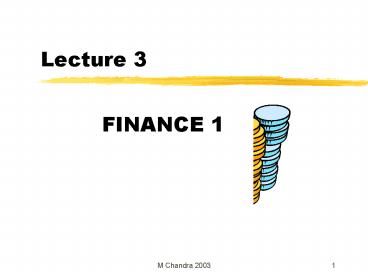FINANCE 1 PowerPoint PPT Presentation
1 / 19
Title: FINANCE 1
1
Lecture 3
- FINANCE 1
2
Lecture Objectives
- Deferred Annuities and Perpetuities
- Understanding the use of NPV formula
- Cashflow and Discount rates
- Impact of tax, inflation and risk on cashflow and
discount rates
3
Deferred Annuities
- Example 1
- What is the present value of a series of payments
of 1000 per year for 4 years if the first
payment starts at the end of the 4th year?
Interest is 10 p.a.. - What is the future value of the above?
4
Deferred Perpetuities
- Example 2
- You wish to set up a scholarship that pays the
top student in the finance course 1000.
Assuming that this scholarship is to last forever
and that interest is 10, how much must be set
aside today if the scholarship is to start in 4
years time?
5
Understanding Net Prevent Value (NPV)
- The NPV calculation is instrumental in the
evaluation of investments. - An example
- The NPV formula
- CF1 CF2 CFn
- NPV ------ ------ ..... ------
- Io - (1i)1 (1i)2 (1i)n
6
Understanding Net Prevent Value (NPV) cont...
- The variables are
- CF - Cashflow
- i - Required rate of return
- n - The number of cashflow
- also Timing of cashflow
7
What is a Cash Flow?
- In finance we only consider actual cash coming in
and going out of a project - Look at incremental cash flows
- Do not include sunk costs
- Consider opportunity costs
- Depreciation is not a cash flow
- Read chapter 12 (we will cover this in detail in
later weeks)
8
What is a C/Flow? cont...
- Hence - Depreciation is not a cash flow, but the
tax deduction on depreciation is. - Cash flow is based on projection (usually derived
from projection of revenue from sales and
expenses).
9
Treatment for Taxation
- Tax is cash flow between the Company and the Tax
Dept. - Hence cash flows are based on net after tax
basis.
10
Treatment for Taxation cont...
- Example Say Coy tax is 40
- Alternatively
- Revenue 20 000 a/t Revenue 20 000(1-tc) 12
000 - Expense -10 000 a/t Expense 10 000(1- tc)
-6 000 - ------- -------
- Net c/f 10 000
- Tax -4 000
- Net a/t c/f 6 000 Net a/t c/f 6 000
- a/t refers to after tax
- Note
- Tax Deductions are a positive c/f
- Tax is generally imposed on income, and tax
relief is gained through expenses.
11
General Treatment of C/Fs with Tax (Rules)
- All incomes and expenses that are cashflows...
- Income (1- tc) net inflow
- Expenses (1- tc) net outflow
- All non cashflow expenses - ie depreciation....
- Expense t net cash inflow.
- Example if depreciation is 20 000
- Then tax shelter on depreciation is
- depreciation x tc
12
General Treatment of Cash Flows with Tax (Rules)
cont...
- Note
- Investment (The purchase of Assets) - is
considered CAPITAL in nature, therefore is not
tax deductable - However, depreciation of the
Asset is. - Read up on
- Category 1, Category 2 and Category 3 companies
13
Treatment for Inflation (Consistency Principle)
- Two ways of adjusting
- 1. Inflate cash flows and find NPV using nominal
discount rate - or
- 2. Use uninflated cash flows and find NPV using
real (adjusted) discount rate
14
Treatment for Inflation (Consistency Principle)
cont...
- Example3
- An investment of 1000 is expected to generate
cash flows of 500 at constant prices, at the end
of each year for 3 years. If inflation rate is
at 10 per annum, and the nominal cost of capital
is 15 per annum, find the NPV of the investment.
15
Treatment for Inflation (Consistency Principle)
cont...
- Using 1st method
- Inflate c/f and use nominal rate
- CF1 CF2 CFn
- NPV ------ ------ .....
------ - Io - (1i)1 (1i)2 (1i)n
- 500(1.1) 1 500(1.1) 2 500(1.1) 3
- ---------- -------- --------
- 1000 - (1.15)1 (1.15)2 (1.15)3
- 373
16
Treatment for Inflation (Consistency Principle)
cont...
- For the example above
- (1 0.15)
- i --------- - 1
- (1 0.10)
- 0.0455
- CF1 CF2 CFn
- NPV --------- --------- .....
------ - Io - (1i)1 (1i)2 (1i)n
- 500 500 500
- --------- --------- ---------
- 1000 (1.0455)1 (1.0455)2 (1.0455)3 - 373
17
Treatment for Inflation (Consistency Principle)
cont...
- Using 2nd method
- Uninflated cashflow and real discount rate
- Note Real interest rate is nominal interest
rate discounted for inflation. This is done
by - 1 Nominal
- (1 Real) ---------------
- 1 Inflation
- (1 i)
- (1 i) --------
- (1 f)
- (1 i)
- i -------- - 1
- (1 f)
18
Treatment for Inflation (Consistency Principle)
cont...
- For the example above
- (1 0.15)
- i ------------ - 1
- (1 0.10)
- 0.0455
19
Treatment for Inflation (Consistency Principle)
cont...
- CF1 CF2 CFn
- NPV ------ ------ ..... ------ -
Io - (1i)1 (1i)2 (1i)n
- 500 500
500 - --------- ---------
--------- - 1000 - (1.0455)1 (1.0455)2 (1.0455)3
- 373

